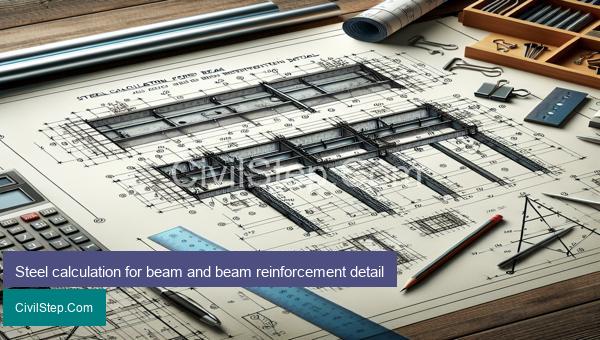
Calculating the necessary dimensions and reinforcement for beams is a crucial aspect of structural engineering. Beams are an essential structural element in any building, providing support and load-bearing capabilities. Correct calculation and proper detailing of beam reinforcement play a vital role in ensuring the stability, strength, and durability of a structure. This article will delve into the fundamentals of beam calculation and detail the necessary steps in determining the optimal dimensions and reinforcement for beams. Understanding these concepts is crucial for engineers to design safe and efficient structures. So, let us explore the world of beam and beam reinforcement detail.
Steel calculation for beam and beam reinforcement detail

Steel calculation for beam:
The steel calculation for a beam involves determining the quantity and size of reinforcement steel required to ensure the structural integrity and strength of the beam. This is a crucial step in the design process of any structural project as the incorrect amount or size of steel can lead to structural failure.
Beam reinforcement detail:
The beam reinforcement detail refers to the specific arrangement of reinforcement steel within the beam to effectively resist tensile and compressive forces. This detail includes the size, spacing, and placement of reinforcement bars, as well as the lap lengths and minimum clear cover required according to the design code.
Steps for steel calculation:
1. Determine design loads: The first step in steel calculation for a beam is to determine the design loads acting on the beam, including dead loads (permanent), live loads (temporary), and any other imposed loads.
2. Analyze and design the beam: Using the design loads, the structural engineer will analyze and design the beam for the required strength and serviceability requirements. This will involve selecting the appropriate beam size, shape, and material.
3. Determine the moment of resistance: The next step is to calculate the maximum moment of resistance (M) that the beam can withstand. This is dependent on the beam size and material properties.
4. Calculate the required reinforcement ratio: The reinforcement ratio (ρ) is the percentage of steel required in the beam cross-section to resist bending moments. This is calculated using the formula ρ = (Ms)/ (bd^2), where Ms is the moment of resistance and b and d are the width and depth of the beam, respectively.
5. Determine the area of steel required: Once the reinforcement ratio is known, the area of steel required can be calculated using the formula As = ρb*d. This will provide the total cross-sectional area of steel needed for the beam.
6. Select reinforcement bar size and spacing: Based on the calculated area of steel, the required number and size of reinforcement bars can be determined. The spacing between bars should also be checked to ensure it meets the minimum requirements.
Beam reinforcement detail:
The reinforcement detail for a beam is typically shown on a structural drawing and includes the following information:
1. Bar size and spacing: The bars should be clearly marked with their diameter and spacing, along with any special detailing requirements such as staggering or bent-up bars.
2. Lap length and anchorage: The lap length of the bars should be specified based on the design code, and the anchorage length at either end of the beam should be clearly indicated.
3. Clear cover: The minimum clear cover required for the reinforcement bars should be shown on the detail, along with any other cover requirements for specific areas such as beam ends or junctions.
4. Special arrangements: In some cases, special reinforcement arrangements may be required, such as distribution bars or stirrups. These should be clearly detailed on the drawing.
It is important to note that the reinforcement detail for a beam may vary depending on the design requirements and the specific project. Therefore, it is essential to follow the design drawings and consult with the structural engineer for any clarifications. Proper steel calculation and reinforcement detailing are vital in ensuring the safety and stability of the beam, and it is crucial to adhere to the design requirements to avoid any potential structural issues.
Beam reinforcement detail

Beam reinforcement detail refers to the specific design and placement of reinforcing bars or steel bars within a concrete beam structure. These reinforcement bars are commonly known as rebars and are essential for providing strength and durability to the beam.
The reinforcement detail of a beam is crucial as it ensures that the beam can withstand the applied loads and stresses without failing. It also helps to prevent cracks and deflections in the beam, which can compromise the structural integrity of the entire building.
The design and detailing of beam reinforcement are based on the structural drawing and specifications provided by the structural engineer. The detailing process starts with identifying the type of beam, its length, width, and thickness. The loads that the beam has to withstand, such as dead loads (self-weight) and live loads (occupant and furniture weight), are also considered during the detailing process.
Once the basic information is gathered, the engineer can start to calculate the required amount of reinforcement steel for the beam. This is determined by considering the strength of the concrete and the design load of the beam. The size, spacing, and number of rebars are carefully selected to achieve the required strength and prevent crack formation.
The placement and layout of reinforcement bars within the beam are also crucial for its structural stability. The spacing between the bars is determined by the diameter of the bars and the thickness of the beam. The closer the bars are placed, the better the load-bearing capacity of the beam. The bars are uniformly spaced along the length of the beam and are securely tied at intersection points with thin wires.
In addition to the longitudinal reinforcement bars, stirrups or ties are also used to provide lateral support. These are placed at regular intervals along the length of the beam to prevent buckling and improve its overall strength. The number and spacing of stirrups depend on the beam’s size, load, and span.
The detailing of reinforcement bars also includes providing adequate cover to the bars to prevent corrosion and maintain the bond between the steel and concrete. The required cover is determined based on factors such as the exposure of the beam to environmental elements and the type of reinforcement used.
Overall, proper beam reinforcement detail is crucial for the structural stability and longevity of a building. It ensures that the beam can resist loads, prevent cracks and deformations, and maintain its strength over time. Therefore, it is essential to follow the specified design and detailing guidelines accurately during the construction process.
Steel calculation for beam

Steel calculation for beam is an essential aspect in the design and construction of any structure. Beams are structural elements that are used to support the load of the building and transfer it to the columns or walls. Steel is the most commonly used material for beams due to its high strength and durability.
Here are the steps involved in steel calculation for a beam:
1. Determine the design loads: The first step in steel calculation for a beam is to determine the design loads. This includes the dead load (the weight of the structure itself), live load (the weight of occupants and furniture), as well as any additional loads such as wind or seismic loads.
2. Select the beam material: The material for the beam is chosen based on its strength, cost, and availability. Steel is the most commonly used material as it has a high strength-to-weight ratio and can be easily fabricated.
3. Calculate the maximum bending moment: The maximum bending moment is the most critical factor in beam design. It is the point where the beam experiences the highest stress and requires reinforcement. The bending moment can be calculated using the load and span of the beam.
4. Determine the section modulus: The section modulus is a measure of the resistance of a beam to bending. It is determined based on the shape and dimensions of the beam section. For a rectangular beam, the section modulus is calculated as (b*h^2)/6, where b is the width and h is the height of the beam.
5. Choose the steel grade: The next step is to select the appropriate steel grade based on the required strength and section modulus. The most commonly used steel grades for beams are A36, A572, and A992.
6. Calculate the required area of steel: The area of steel required for the beam can be calculated using the formula As = M/(0.87*Fy*d), where M is the maximum bending moment, Fy is the yield strength of the steel, and d is the effective depth of the beam.
7. Determine the spacing of reinforcement: Once the required area of steel is calculated, the spacing of reinforcement can be determined based on the diameter of the steel bars and the section of the beam.
8. Check for deflection: In addition to strength, deflection is also an important factor to consider in beam design. The deflection of the beam should be within acceptable limits to prevent any excessive movement or deformation.
In conclusion, steel calculation for beam is a crucial step in the design process to ensure that the beam can withstand the required loads and provide adequate support to the structure. It is important to follow structural codes and standards to ensure the safety and stability of the building.
Conclusion
In conclusion, understanding the calculations for beams and the reinforcement details is crucial for structural engineers and anyone involved in construction projects. A proper calculation ensures the strength, stability, and safety of a beam, which is a fundamental element in any structure. By using the correct formula and taking into account all necessary factors, engineers can design highly efficient and reliable beams. Additionally, proper detailing of the reinforcement is essential to ensure the beam can withstand the intended load and prevent any potential failure. Therefore, it is essential to have a thorough understanding of the calculations and reinforcement detailing for beams to ensure the overall integrity of a structure.
